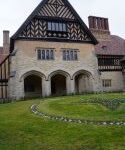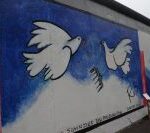
 March 15, 2018
March 15, 2018
While “East Side, West Side, all around the town” was written about New York City, probably no city in the world would have a better claim to East and West than Berlin, which was actually both really and symbolically severed into Eastern and Western zones from the end of World War II until the end of 1989.
Reminders of the cold war, two world wars, the Weimar Republic, the First, Second, and Third Reich still mark the history of the city, which is both reasonably far north (52 degrees) and East in Europe.
We’re at the Adlon Hotel, a rebuilt five-star attraction in sight of the Brandenburg Gate, one of the former gates to the city of Berlin—and perhaps the most important, since the political development of Berlin originated in the Elector of Brandenburg, a member of the House of Hohenzollern. The “mother church” of the Hohenzollerns was in East Prussia, and the Kings in Prussia (beginning in 1701 and ending with Wilhelm II in 1888) were crowned in Konigsburg, now the Russian Kaliningrad.
Berlin has been settled a long time, but it’s importance has grown under one of my favorite kings, Frederick the Great (of course), who made major strides in integrating Prussia into Europe (wars expanded the kingdom westward) and got his title changed to King of Prussia.
We spent about half of yesterday touring Berlin proper, and about half of the rest of the day in Potsdam, where the Hohenzollerns built most of their 40 local castles. The city proper still has remnants of the bitter fighting in April 1945, when Hitler, in a last gasp of megalomania ordered his soldiers to fight to the death. There are bullet holes remaining in some of the buildings in Berlin. Some of the “highlights” were destroyed in World War II, (including the city palace, now being rebuilt) or were left (particularly by the Soviet-East Germans) to fall into disrepair, so that they could build East Germany into a “Worker’s Paradise.” That was the fate of the Spandau prison, for example.
 Ironically, the palaces in Potsdam escaped major damage, which was one reason why the last of the “wartime conferences” –with the revamped Big Three (Stalin, Truman, and Churchill—replaced midway by Clement Atlee, the Labor leader whose party won an election)—met for the “Big Three” conference that has come to be called Potsdam. The palace built in the early 20th century for the Crown Prince (looking for all the world like the Ewing Manor, but about 20X the size) is English Tudor, reflecting the love-hate relationship the Hohenzollerns had with their Windsor cousins, who sat on the throne in England. There’s a large table in a room with, happily, three equal-sized doors, so each country could have an equal
Ironically, the palaces in Potsdam escaped major damage, which was one reason why the last of the “wartime conferences” –with the revamped Big Three (Stalin, Truman, and Churchill—replaced midway by Clement Atlee, the Labor leader whose party won an election)—met for the “Big Three” conference that has come to be called Potsdam. The palace built in the early 20th century for the Crown Prince (looking for all the world like the Ewing Manor, but about 20X the size) is English Tudor, reflecting the love-hate relationship the Hohenzollerns had with their Windsor cousins, who sat on the throne in England. There’s a large table in a room with, happily, three equal-sized doors, so each country could have an equal entrance (but the flags rotated from day to day so that no single flag stayed in the center) where the participants met, and decided, among other things, on the partition of Germany and Poland, and the denazification of Germany. I hadn’t been to that palace before, and was a little surprised to learn that the Crown Prince came back to Germany after 1918, and flirted with Hitler (who toyed with restoring the monarchy), and lived in the palace until the threat from Soviet troops led him to flee. One of the royal relatives, too, died in Windhoek, (now Namibia), where there’s still a German presence.
entrance (but the flags rotated from day to day so that no single flag stayed in the center) where the participants met, and decided, among other things, on the partition of Germany and Poland, and the denazification of Germany. I hadn’t been to that palace before, and was a little surprised to learn that the Crown Prince came back to Germany after 1918, and flirted with Hitler (who toyed with restoring the monarchy), and lived in the palace until the threat from Soviet troops led him to flee. One of the royal relatives, too, died in Windhoek, (now Namibia), where there’s still a German presence.
The most complete of the palaces is the summer palace of Frederick the Great, the well-named San Souci (carefree), where he would retire for the summer, and play his flute (he composed concerti), converse with Voltaire in French (he spoke German, he said, only to his horses), and discuss philosophy with the philosophes—when not making war, particularly on Maria Theresa of Austria (he coveted Silesia, with its industrial potential!). His father had bequeathed him a military establishment that was the envy of Europe, and enough money to build a rococo palace that is still one of the major attractions of Berlin. Tours are costly (about $25), and limited to a certain number of guests a day. It really is a stunning look at paintings and décor of the period.
for the summer, and play his flute (he composed concerti), converse with Voltaire in French (he spoke German, he said, only to his horses), and discuss philosophy with the philosophes—when not making war, particularly on Maria Theresa of Austria (he coveted Silesia, with its industrial potential!). His father had bequeathed him a military establishment that was the envy of Europe, and enough money to build a rococo palace that is still one of the major attractions of Berlin. Tours are costly (about $25), and limited to a certain number of guests a day. It really is a stunning look at paintings and décor of the period.
The other palace open during the winter in Potsdam is being renovated. It was where Wilhelm II, the last Kaiser, lived. When he left it in 1918 (he abdicated and moved to the Netherlands), he apparently took all the furniture with him. I remember the rooms as sumptuous, but relatively empty.
On the road to Potsdam, we drove over another reminder of the Cold War—the bridge of spies, which was the border between East and West. There were at least three exchanges of spies there—subsequently made into a movie—including, if I remember it correctly, Gary Powers, who was shot down in a spy plane over the Soviet Union (my fraternity for a time created a position for a spy plane pilot).
There were at least three exchanges of spies there—subsequently made into a movie—including, if I remember it correctly, Gary Powers, who was shot down in a spy plane over the Soviet Union (my fraternity for a time created a position for a spy plane pilot).
The Cold War in the city is captured best in the remnants of the Berlin Wall. Our guide, who had grown up in East Berlin, talked about  the effort of the Russians to showcase East Berlin. The East sector, ironically, got many of the traditional tourist sights (the Museums, State Opera, etc.) Unfortunately for the East German communists (the party incidentally still exists and is headquartered in a posh building in Potsdam, not fit for a proletariat!), life in the West was so much more attractive that in 1961, the East German government erected a wall to keep East Germans from fleeing. In the next almost 30 years, over 1000 East Germans died trying to escape. Parts of the wall still exist, covered with approved artistic graffiti.
the effort of the Russians to showcase East Berlin. The East sector, ironically, got many of the traditional tourist sights (the Museums, State Opera, etc.) Unfortunately for the East German communists (the party incidentally still exists and is headquartered in a posh building in Potsdam, not fit for a proletariat!), life in the West was so much more attractive that in 1961, the East German government erected a wall to keep East Germans from fleeing. In the next almost 30 years, over 1000 East Germans died trying to escape. Parts of the wall still exist, covered with approved artistic graffiti.

The other remnant of the Cold War was Checkpoint Charlie, one of three crossing points between East and the US Zone. The others were Able and Baker. (ABC) The Checkpoint is manned by “soldiers” in US uniform (East Europeans, snickered our guide), who for a 3 Euro “gift” will let you take pictures with them. Though the wall is down, some things in Berlin never change.